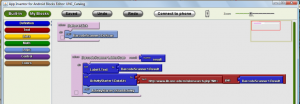It took a while, but Friday afternoon I finally got an invite to use Google’s App Inventor program. What is App Inventor? It’s Google’s attempt to simplify building apps for Android devices. Apps are built using a drag and drop interface, and reflected instantly on a connected Android device.

I was skeptical about the system’s ability to produce apps of any real functionality, but I was happy to be proven mostly wrong. Building a well-structured UI is admittedly almost impossible, with only basic layout and design tools available. But the app inventor does provide easy access to surprisingly complex elements of the Android functionality. The GPS, barcode scanner, camera, speech recognition, and accelerometer are among the tools easily usable via drag and drop. After placing buttons and labels to design the UI, a separate drag and drop interface is used to establish how those elements interact with each other. A series of blocks click into each other, with a bit of typing to provide some details.
It’s a nice system, and my skepticism about App Inventor’s potential beyond the toy level was quickly overcome. I ran through the first tutorial app (touch the picture of a cat and it meows! This didn’t help my skepticism…) in a few minutes. Less than an hour later I’d built an app to search the UNC catalog via an ISBN barcode scan. It relies heavily on our existing catalog webapp to do the actual search, but still! I mastered using the barcode scanner for apps in less than an hour. My previous attempt at Android programming (in Java, before App Inventor existed) took me four hours to build an app that simply displays an image. And that simple task drew on every single bit of programming know-how I could dredge up from my undergrad days.
The barrier to entry for using App Inventor is almost absurdly low. My slight background in programming did help, and I would have taken a bit longer if I wasn’t familiar with things like variables and function returns. But the point of App Inventor is that I wasn’t required to know those things in advance. I could have picked it up in a little extra time. This kind of setup seems perfect for intro-level computer science courses, teaching basic programming concepts while retaining the satisfaction of seeing a fully functional app at the end. Google definitely realizes this and is targeting educators as potential users.
App Inventor is clearly still a beta product, with some notable limitations. Apps built in App Inventor can’t be distributed in the Android Market. The install files need to be manually distributed to phones. There’s also no resulting Java source code to tweak for more advanced purposes. And disappointingly, using APIs beyond a prescribed few (Twitter, Amazon, etc) involves more complicated Python coding. There’s also some strange odds and ends, like not being able to change the app’s icon.
I’m not under any illusions that App Inventor apps will someday replace Java-coded apps. But it got me excited about programming in a way I haven’t been in years. That’s gotta count for something.
If you’d like to try the barcode scanner app I built and see what App Inventor is capable of, here’s the installable apk file: http://dl.dropbox.com/u/905114/UNC_Catalog.apk
